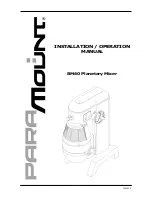
7
AM442D/AM642D
8. Record Out
T h e s e o u t p u t s w i l l
accommodate RCA cables,
able to be fed to a variety
of recording devices.
9. 2T Return
These RCA inputs are
used to connect the mixer
with external devices, such
as CD, Tape and Cassette
Players.
10. Main Out
These two XLR jacks will
output the final stereo
line level signal sent from
the main mixing bus. The
primary purpose of these
jacks is to send the main output to external devices,
which may include power amplifiers (and in-turn, a
pair of speakers), other mixers, as well as a wide
range of other possible signal processors (Equalizers,
Crossovers, etcetera).
Rear Panel
11. Channel Inserts
Located on the rear of the AM 442D and AM 642D,
the primary use for these TRS phone jacks is for
the addition of external devices, such as dynamic
processors or equalizers, to mono input channels 1
through to 4 on the AM 442D and 1 through 6 on the
AM 642D. This send and return will require a Y cord
that can send (pre-fader and pre-EQ) and receive
signals to and from an external processor.
12. Control Room Outputs
These two 1/4” phone jack outputs feed the signal
altered by the Control Room / Phones level control
on the face of the mixer. This output has extensive
use, as it can be used to feed the signal from the
mixer to an active monitor, for the monitoring of the
audio signal from within a booth, or, alternatively, for
the addition of external signal processing devices
or mixers, as well as acting as a “side fill” output,
supplying audio to indoor areas that the main
speakers do not reach.
13. Group Out
These 1/4” phone jacks output the final feed from
the Group 1 and 2 Faders on the main mixer. These
outputs can be used to feed a wide range of devices,
such as mixers, signal processors, and even to
connect an amplifier and speakers to be used along
with the Main Speakers, for a more rounded audio
experience.
14. Main Out
These two XLR ports will output the final stereo
line level signal sent from the main mixing bus.
The primary purpose of these jacks is to send the
main output to external devices, which may include
power amplifiers (and in-turn, a pair of speakers),
other mixers, as well as a wide range of other
possible signal processors (equalizers, crossovers,
etcetera).








































